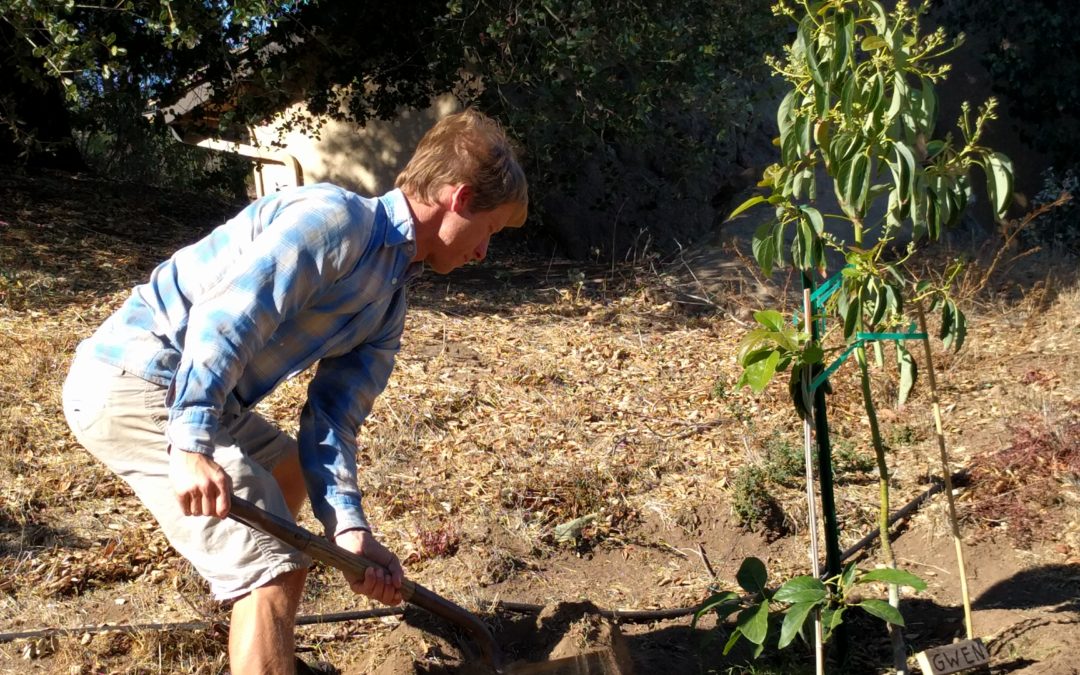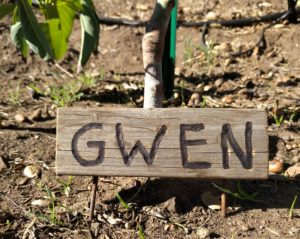Our third child was born last week, a baby girl named Reeve. The nurses put the placenta in a plastic container for us without discussion or funny looks; my wife is a labor and delivery nurse at the hospital, so these nurses are her friends. But also, this had become a routine, for it was the third time now that we’d asked to take our newborn’s placenta home so we could plant a tree over it.
I don’t now recall where we’d gotten the idea to plant a placenta tree with our first born. My wife and I met while we were both living in Africa, but this isn’t something they did there. It’s not a family tradition either; I don’t have a placenta tree that my father planted. But I do remember not wanting to treat the placenta like trash, as hospitals do — “biohazardous” trash, they call it.
The placenta is a wonder organ to my mind. It grows alongside the baby in the womb and acts as the middleman between the baby and the mother. Through the placenta the baby gets oxygen, and through the placenta the baby gets food in the form of simple nutrients like protein and carbohydrates. These come from the mother into the placenta and then travel the umbilical cord into the baby, all in a blood solution. I’m paraphrasing one of my wife’s nursing textbooks here, but one look at the placenta shows that it’s essentially a mass of blood vessels.
As a father, holding my daughter’s placenta and planting it with a tree gives me a connection to her birth, an event that is otherwise more remote. It’s her mother who carried her for nine months, delivered her with trial into this world, and now sustains her through breastmilk. Me, her dad? At this stage, I try to hold her without making her cry so mom can take a shower. Beyond that, I’m of little use.
But I imagine that someday my little Reeve will think it’s kind of cool to show her friends that avocado tree over there that her crazy dad planted. It’s the same age as me. It fed off my placenta when it was young. It’s a Gwen avocado tree. Want to pick one — eat an avocado from my tree?
I took my sweet time selecting Reeve’s placenta tree. I chose a Gwen in part because it’s a girl’s name. I had considered a Hellen or Queen avocado too, but ultimately landed on Gwen because it’s a small tree for an avocado yet it’s remarkably productive, and the fruit tastes exceptionally rich. It ranks as a favorite among many avocado aficionados.
(Here is a short video profile I made of the Gwen avocado.)
I also love the story behind the name. Bob Bergh grew tens of thousands of new and unique avocado trees during almost 40 years of his research career at the University of California, Riverside. But only one — (one!) — originally referred to as T225, did Dr. Bergh feel was special enough to name in honor of his wife, Gwen.
(Read more in “The Gwen Avocado” in the 1988 Yearbook of the California Avocado Society.)
Such an avocado tree might be special enough to grow in my yard along with my only daughter, Reeve. It was always going to be some kind of avocado though. I never seriously considered another type of tree. Reeve’s two older brothers already had avocado trees growing over their placentas.
How do you choose which type of tree to plant over your child’s placenta? It was an intimidating decision for me. I thought about a number of things, the most important being how long a particular type of tree could be expected to live. No fun if you plant a peach that is half dead by the time your child graduates high school (peaches are not known for their longevity). Avocados, on the other hand, often outlive the people who planted them.
(See pictures of some in my post, “Among some of the oldest avocado trees in California, at The Huntington”.)
I also knew that an avocado would thrive in the climate of my yard. No fun either if you plant a cashew that never fruits (or nuts) because it’s too cold in your yard, or if you plant a filbert that never produces because the winters aren’t cold enough. (Around Southern California here, I’d consult the Sunset Western Garden Book or a local independent nursery as repositories of information on which trees will thrive in your yard — only after observing what trees are already thriving in the yards of your neighbors, for that’s always the most reliable information.)
Avocado trees also made sense as placenta trees for our particular situation because I already had experience growing them, my wife and I both find them attractive in the landscape, and we love to eat the fruit. Can you make too much guacamole?
If I had to do it all over again though, I would choose avocado varieties that are ripe on each child’s birthday. That would be extra cool, crazy dad. Then again, that wouldn’t be ideal for our situation since all of our kids have been born in the winter. Maybe you can make too much guacamole. So I tried to at least choose varieties that are ripe at different times.
Okay, if I’m imagining doing it all over again (for your sake, because you might be able to avoid some mistakes I made), I’d be a more vigilant gardener father, too. Sadly, I had to cut down and replant my second son’s placenta tree just this fall because of the debilitating damage done by at least four separate gophers attacking it over the preceding two years. It didn’t feel good to lose such a special tree on my watch. Protect the placenta trees, crazy dad.

The least I could do was give Miles and Cass the pleasure of chopping it up before I planted the replacement.
So here I go. After probing the nearby soil for gopher tunnels, I planted and staked the Gwen avocado tree. I carved and colored a sign for it. And then Reeve was born. I brought home her placenta, dug a hole beside the tree, held her placenta in my hand and placed it in the hole.
With my first son, I’d placed the placenta in a hole and planted the tree directly on top, but with my second son’s and Reeve’s trees I chose to place the placenta just to the side so the trees wouldn’t sink as the placentas decomposed. I don’t know if that really matters, but that’s what I’ve done.
As I buried Reeve’s placenta, scooping dirt over it with the hand in which I’d held it, I finished up with a blood and dirt crust over my palm and fingers, and I stayed on my knees there for a moment feeling a palpable connection to my daughter’s start to life. May Gwen and Reeve grow strong together.
You might also like to read these posts:







Dang Greg, are you trying to make everyone cry on the last Friday of the year…Great post. Thanks for sharing. Love the pictures of Urs and the little ones. You can see the joy these trees bring.
Congratulations on the birth of your daughter Reeve. I enjoyed reading the planting of the avocado tree and always enjoy your articles.
Touching, my friend. Thanks for sharing.
I agree, very touching. I love imagining the kids going to their tree for their entire life. I love that they have a tangible gift from you that should last their entire lives. What a beautiful gift, brother. Hugs!
Thanks, you guys, for the kind comments.
I don’t know how I missed this post last week. But I’m really glad I found it today, even with tear filled eyes. Your intention is so sweet and special. Your kids are blessed to have parents who love them so much, and can express that love through feeding them and writing about that process, and teaching them what you know. Well done!
My, oh my! I should have guessed you were a Renaissance man. My Steve’s birthday is 12/27, so I also feel for celebrating the birth of a child so close to Christmas, regardless of one’s actual faith – or not. Once you settle into a routine of the normal newborn challenges, I’d love to invite you over – with your family too if you’d like, just to connect a bit more. I have never been to Africa myself, but I am a traveler of sorts. Most of my adventures have been in North American wilderness and adjacent urban spaces, but much more than many Americans experience. I found your BLOG through the MG seminar link, so WOW. Tree people share so many appreciations of global life. I have begun calling myself an urban ecologist, rather than a gardener these days. I’d bet you’d enjoy reading about my dear college friend Doug, and his “Sacred Trees of Norway”. https://news.prescott.edu/news/article/professor-doug-hulmes-presents-international-forum-sustainability Keep up your writing. It is precious.
Robin! Thank you! I’ll be getting in touch about a visit.
Thanks for the link about Doug Hulmes. I look forward to reading more about his work.
I was interested in trees before I became interested in gardening. And then I got very interested in vegetables. But I feel myself coming back to trees. Their longevity and character, not to mention all that they provide for us, fascinates me.
Hey Greg. That tree your boys are destroying looks like it has lots of green leaves on it. It must have been a tough decision to replace it, so I’m assuming it just failed to thrive for too long and you couldn’t wait any longer for it to recover from those pesky gophers, right? Can I ask how long you give an underperforming avocado tree a chance to earn a place in your yard before you replace it?
Hi Keith,
It’s true that that tree looks like it’s not in too bad of shape, but I’m impatient with young trees that aren’t thriving. It depends a bit on why, however. With that tree in particular, the gophers had damaged it so many times that when I dug around I could not find many roots, and the few I did find were not healthy cream-colored ones. I just didn’t see it recovering.
I have a pretty good sense of how well a young tree can grow, so if it’s not growing well I usually don’t pamper it for more than a year, maybe two. If it hasn’t made a strong comeback in that span of time, it probably won’t come back — at least not faster than a newly planted tree.
Small trees that don’t have healthy canopies end up getting sunburned in my hot inland yard almost no matter how hard I try to stop it. The sunburn then impedes their recovery and it’s a downward spiral. I find that I give up on damaged young trees faster and faster every year.
But I do sometimes pamper trees that are hard to replace. For example, I have a Queen that was damaged in last July’s heat. It’s limping along. I haven’t cut it down just because it isn’t easy to find another Queen tree.
Also, if a bigger tree isn’t producing fruit, I have no patience for it. I’m not on a well. Water is expensive. I will quickly give that space to someone else who produces. For example, I cut down a SirPrize tree a year or two ago because it wasn’t productive after five years in the ground. SirPrize fruit is good but it’s not that good.